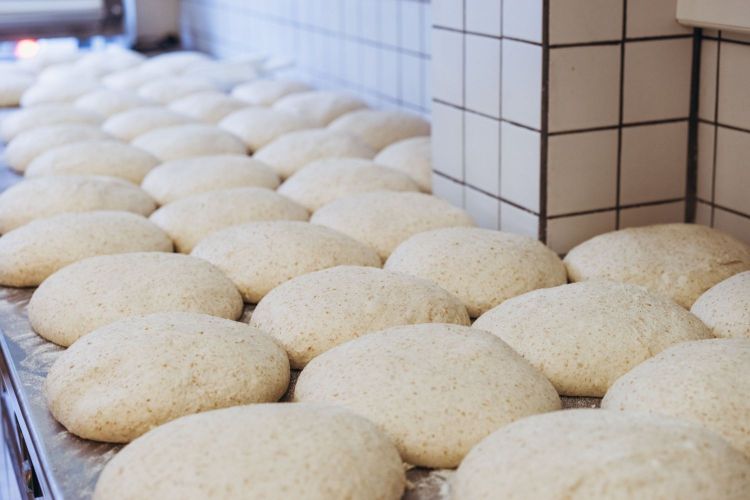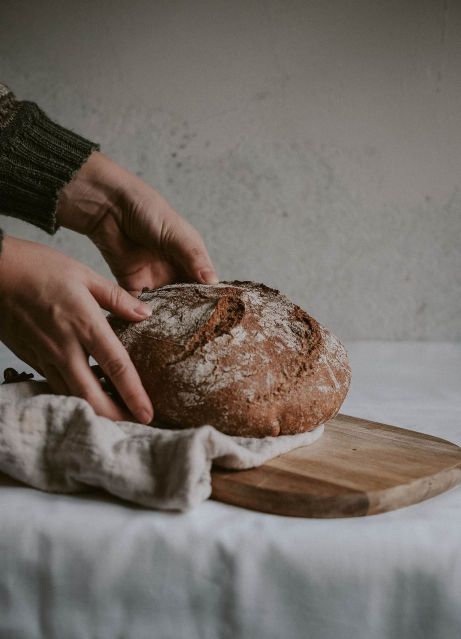Why is my bread dough sticky is a common question among bakers.
Sticky bread dough can ruin the baking experience, but it’s a common issue that can be easily fixed.
Understanding the factors that contribute to sticky bread dough is crucial for troubleshooting the issue and achieving the desired result.
Moisture, flour type, temperature, and proportion of ingredients are some of the factors that affect the dough’s stickiness.
In this article, I’ll discuss these factors in detail and provide tips on how to fix sticky dough.
With some practice and adjustments, you’ll be able to master the art of bread baking and create delicious loaves of bread.
Why Is My Bread Dough Sticky – Revealed
As a baker myself, I know how frustrating it can be to deal with sticky bread dough. It can ruin your day, and you might end up with a dense and unappetizing loaf of bread.
However, over the years, I’ve figured out that it’s important to know what makes bread dough sticky so we can fix the problem and get the bread we want.
Here are the 4 main factors that contribute to sticky bread dough:
1. Moisture
When it comes to bread dough, moisture is a crucial factor that affects its consistency.
If there’s too much moisture in the dough, it can become sticky and challenging to work with, which can ultimately affect the rising and developing process of the dough.
To avoid this issue, it’s essential to measure the ingredients accurately and adjust the recipe if necessary.
Also, the type of flour used in the dough can impact the amount of moisture it can absorb.
For example, whole-grain flour absorbs more moisture than white flour, which can affect the dough’s consistency.
2. Flour Type
The type of flour used in bread dough can significantly impact its consistency.
Different types of flour have varying absorbency levels and gluten content, which can affect the dough’s stickiness.
For instance, bread flour and all-purpose flour are more absorbent and contain more gluten than other types of flour, making the dough more difficult to work with.
Therefore, it’s crucial to use the right type of flour for your recipe to achieve the desired consistency.
Additionally, the quality of flour can also affect the dough’s stickiness. High-quality flour that’s properly stored and fresh can make the dough less sticky.
3. Temperature
Temperature is another critical factor in creating sticky bread dough. If the dough is too warm, it can become soft and sticky, making it challenging to handle.
On the other hand, if the dough is too cold, it can be difficult to knead and shape.
Therefore, it’s crucial to follow the recipe instructions carefully and maintain the ideal temperature for the dough.
Additionally, the room temperature can also affect the dough’s consistency.
If the room is too warm, the dough can rise too quickly, making it challenging to handle.
4. Proportion of Ingredients
The proportion of ingredients used in bread dough can also affect its stickiness. If there’s too much liquid in the dough, it can counteract the flour and cause it to become sticky.
Therefore, it’s crucial to measure the ingredients accurately and adjust the recipe if necessary.
Additionally, the order in which the ingredients are added can also affect the dough’s consistency.
Adding the liquid ingredients to the flour slowly and mixing them thoroughly can prevent the dough from becoming too sticky.

In addition to the factors mentioned above, other factors such as humidity and altitude can also affect the bread-making process.
High humidity can cause the dough to absorb more moisture, making it sticky. On the other hand, low humidity can cause the dough to dry out and become stiff.
Similarly, altitude can also affect the dough’s consistency. At higher altitudes, the air pressure is lower, which can cause the dough to rise faster and become too soft and sticky.
How to Fix Sticky Dough in 5 Steps
Bread baking is an art, and the sticky dough can be one of the biggest challenges to deal with.
But don’t worry! Here are some tips to help you fix sticky bread dough like a pro.
1. Add More Flour Gradually
Adding more flour is a great way to fix this issue! The trick is to add it gradually and not all at once.
To do this, you can start by adding a tablespoon of flour at a time and kneading the dough well between each addition.
This way, you can get a feel for how much more flour is needed without making the dough too dry.
You want to end up with a dough that is smooth and elastic, but not too dry.
Keep in mind that the amount of flour needed can vary based on factors like the type of flour used and the humidity in the environment.
So, pay attention to the dough’s texture and adjust accordingly.

Another tip is to lightly flour your hands and work surface. This will make it easier to work with the dough and prevent it from sticking.
2. Use a Different Type of Flour
When it comes to making dough, the type of flour used can have a significant impact on its texture and stickiness.
For instance, bread flour contains more protein compared to other types of flour, resulting in a firmer and less sticky dough.
Therefore, using bread flour can be a good option when preparing dough for bread.
Alternatively, whole wheat flour is also a great choice since it absorbs more moisture compared to white flour.
This makes it a suitable option when making dough for pizza crust or other baked goods that require a crispy texture.
It’s crucial to experiment with different types of flour to determine the one that best suits your needs.
You may want to try using different types of flour to see how each type affects the dough’s texture and stickiness before deciding which one to use for a specific recipe.
By doing so, you can ensure that your baked goods come out perfectly every time.
3. Knead the Dough
The process of kneading dough is essential in bread-making as it helps to create a smooth and uniform texture.
Kneading for a longer duration helps to distribute moisture evenly throughout the dough, resulting in a less sticky consistency.
Additionally, kneading dough aids in the development of gluten, a protein that contributes to the structure and texture of the bread.
Gluten helps the dough to trap air, giving the bread its desired texture and chewiness.
However, it is important to note that over-kneading can lead to a tough dough that is difficult to work with.
To prevent over-kneading, You need to pay close attention to the dough’s texture and feel. You should aim to achieve a smooth, elastic dough that is not too sticky or dry.

Depending on the type of bread being made, the duration of kneading can vary, and bakers should follow the recipe instructions carefully.
4. Allow the Dough to Rest
To achieve a better texture and reduce stickiness, it is recommended to allow the dough to rest and rise for a longer period.
This process provides ample time for the dough to absorb moisture and develop a more manageable consistency.
Moreover, letting the dough rise for a longer time enhances the flavor of the bread, leading to a more delicious and flavorful final product.
The extended resting period allows the yeast to fully ferment and produce the desired flavors and aromas.
5. Use a Stand Mixer
Using a stand mixer with a dough hook attachment can be a great solution.
The mixer’s powerful motor and the unique design of the dough hook can effectively knead the dough, making it less sticky and easier to handle.
It’s important to note, though, that while a stand mixer can be a helpful tool, overusing it can have negative effects on your dough.

Overmixing can make the dough too tough, resulting in a less desirable texture.
Therefore, it’s crucial to use the mixer for just the right amount of time, based on the specific recipe and type of dough you are working with.
Additionally, when using a stand mixer with a dough hook, it’s important to keep an eye on the dough throughout the mixing process.
If the dough is still too sticky or not coming together properly, it may need additional kneading by hand or adjustments to the recipe.
With proper care and attention, a stand mixer with a dough hook attachment can be a valuable tool for any home baker dealing with sticky dough.
How to Fix Sticky Dough Without Flour?
If your dough is sticky and you don’t have flour on hand, there are a few options to fix it.
First, try adding a small amount of oil or melted butter to the dough and knead it in. This can help reduce stickiness.
Alternatively, you can wet your hands with water and continue kneading the dough.
The moisture from your hands will help to make the dough less sticky.
Another option is to refrigerate the dough for about 15-30 minutes to allow it to firm up.
Finally, if the dough is too sticky to work with, you can try incorporating small amounts of cornstarch or powdered sugar to absorb the excess moisture.
How to Fix Sticky Dough After Rising?
As an avid home baker, you’re likely familiar with the frustration of checking on your bread dough after it’s had time to rise, only to find that it’s still sticky and unmanageable.
Don’t panic – this is a common issue that can be easily fixed with a few simple solutions. Here are some steps you can take to fix sticky dough after rising:
- Use Oil or Butter: If adding more flour doesn’t solve the problem, try using a little oil or butter. This will lubricate the dough and make it easier to work with. Rub a small amount of oil or butter onto your hands and the work surface before handling the dough.
- Divide and Conquer: If the dough is too sticky to work with as a whole, divide it into smaller pieces. This will make it easier to handle and knead. Once you’ve worked with each piece, you can combine them back together.
- Use a Dough Scraper: A dough scraper can help handle the sticky dough. Use it to scrape the dough off the work surface and fold it over itself. This will help incorporate any additional flour or oil/butter that you’ve added.
- Be Patient: Finally, remember that sticky dough can be frustrating, but it’s not the end of the world. Take your time and be patient with the dough. Knead it well and give it time to rise again if necessary.
Does Sticky Dough Make Good Bread?
Well, the answer is not a straightforward yes or no. A sticky dough can actually make a loaf of good bread, but it depends on various factors, such as the type of bread, the recipe, and the baker’s experience.
First, it’s important to understand that different types of bread require different dough consistencies.

For example, some bread, like ciabatta or focaccia, are known for their high hydration levels, which make the dough sticky.
In such cases, sticky dough is desirable as it helps to create a light, airy texture in the bread.
On the other hand, some bread, like bagels or pretzels, requires a firmer dough.
In such cases, a sticky dough can make it challenging to shape the bread, resulting in a less desirable texture.
The recipe is also a crucial factor in determining whether a sticky dough will make good bread.
Some recipes are more forgiving when it comes to dough consistency, while others require more precise measurements.
If a recipe calls for a specific hydration level, it’s important to follow it closely to achieve the desired results.
Lastly, Your experience and technique can also play a role in the success of the bread.
A more experienced baker may know how to work with a sticky dough to achieve the desired results, while a novice may struggle with it.
Techniques, like folding and stretching the dough, and using a well-floured surface, can help make the dough more manageable.
Why Is My Bread Dough Sticky – Conclusion
In conclusion, Why is my bread dough sticky is a common question among home bakers.
Understanding the factors that contribute to sticky bread dough is crucial for achieving the desired result in baking.
The four main factors that can cause sticky dough are moisture, flour type, temperature, and the proportion of ingredients.
To fix sticky bread dough, gradually add more flour while kneading, and using a different type of flour can be helpful.
Additionally, accurately measuring ingredients and adjusting the recipe if necessary, mixing the ingredients in the right order, and paying attention to the dough’s texture can also prevent the dough from becoming too sticky.
With these tips and some practice, you can master the art of bread baking and create delicious loaves of bread.

